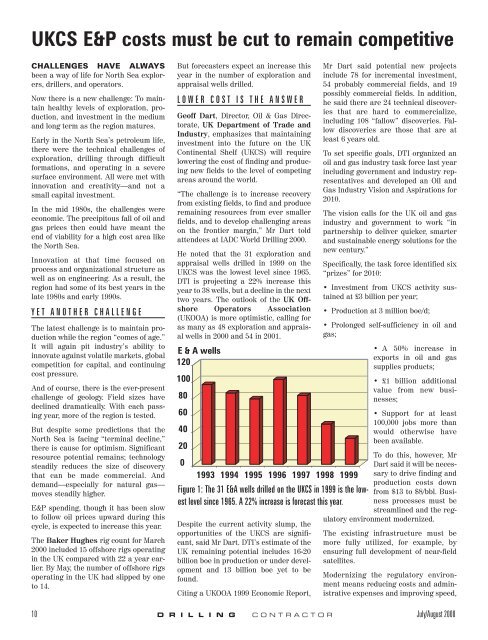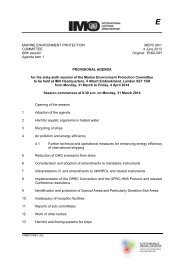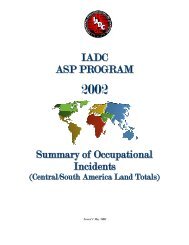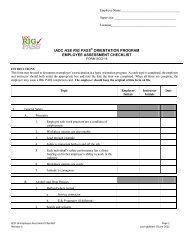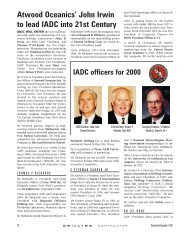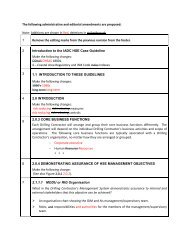UKCS E&P costs must be cut to remain competitive - IADC
UKCS E&P costs must be cut to remain competitive - IADC
UKCS E&P costs must be cut to remain competitive - IADC
Create successful ePaper yourself
Turn your PDF publications into a flip-book with our unique Google optimized e-Paper software.
<strong>UKCS</strong> E&P <strong>costs</strong> <strong>must</strong> <strong>be</strong> <strong>cut</strong> <strong>to</strong> <strong>remain</strong> <strong>competitive</strong><br />
CHALLENGES HAVE ALWAYS<br />
<strong>be</strong>en a way of life for North Sea explorers,<br />
drillers, and opera<strong>to</strong>rs.<br />
Now there is a new challenge: To maintain<br />
healthy levels of exploration, production,<br />
and investment in the medium<br />
and long term as the region matures.<br />
Early in the North Sea’s petroleum life,<br />
there were the technical challenges of<br />
exploration, drilling through difficult<br />
formations, and operating in a severe<br />
surface environment. All were met with<br />
innovation and creativity—and not a<br />
small capital investment.<br />
In the mid 1980s, the challenges were<br />
economic. The precipi<strong>to</strong>us fall of oil and<br />
gas prices then could have meant the<br />
end of viability for a high cost area like<br />
the North Sea.<br />
Innovation at that time focused on<br />
process and organizational structure as<br />
well as on engineering. As a result, the<br />
region had some of its <strong>be</strong>st years in the<br />
late 1980s and early 1990s.<br />
YET ANOTHER CHALLENGE<br />
The latest challenge is <strong>to</strong> maintain production<br />
while the region “comes of age.”<br />
It will again pit industry’s ability <strong>to</strong><br />
innovate against volatile markets, global<br />
competition for capital, and continuing<br />
cost pressure.<br />
And of course, there is the ever-present<br />
challenge of geology. Field sizes have<br />
declined dramatically. With each passing<br />
year, more of the region is tested.<br />
But despite some predictions that the<br />
North Sea is facing “terminal decline,”<br />
there is cause for optimism. Significant<br />
resource potential <strong>remain</strong>s; technology<br />
steadily reduces the size of discovery<br />
that can <strong>be</strong> made commercial. And<br />
demand—especially for natural gas—<br />
moves steadily higher.<br />
E&P spending, though it has <strong>be</strong>en slow<br />
<strong>to</strong> follow oil prices upward during this<br />
cycle, is expected <strong>to</strong> increase this year.<br />
The Baker Hughes rig count for March<br />
2000 included 15 offshore rigs operating<br />
in the UK compared with 22 a year earlier.<br />
By May, the num<strong>be</strong>r of offshore rigs<br />
operating in the UK had slipped by one<br />
<strong>to</strong> 14.<br />
But forecasters expect an increase this<br />
year in the num<strong>be</strong>r of exploration and<br />
appraisal wells drilled.<br />
LOWER COST IS THE ANSWER<br />
Geoff Dart, Direc<strong>to</strong>r, Oil & Gas Direc<strong>to</strong>rate,<br />
UK Department of Trade and<br />
Industry, emphasizes that maintaining<br />
investment in<strong>to</strong> the future on the UK<br />
Continental Shelf (<strong>UKCS</strong>) will require<br />
lowering the cost of finding and producing<br />
new fields <strong>to</strong> the level of competing<br />
areas around the world.<br />
“The challenge is <strong>to</strong> increase recovery<br />
from existing fields, <strong>to</strong> find and produce<br />
<strong>remain</strong>ing resources from ever smaller<br />
fields, and <strong>to</strong> develop challenging areas<br />
on the frontier margin,” Mr Dart <strong>to</strong>ld<br />
attendees at <strong>IADC</strong> World Drilling 2000.<br />
He noted that the 31 exploration and<br />
appraisal wells drilled in 1999 on the<br />
<strong>UKCS</strong> was the lowest level since 1965.<br />
DTI is projecting a 22% increase this<br />
year <strong>to</strong> 38 wells, but a decline in the next<br />
two years. The outlook of the UK Offshore<br />
Opera<strong>to</strong>rs Association<br />
(UKOOA) is more optimistic, calling for<br />
as many as 48 exploration and appraisal<br />
wells in 2000 and 54 in 2001.<br />
E & A wells<br />
120<br />
100<br />
80<br />
60<br />
40<br />
20<br />
0<br />
1993 1994 1995 1996 1997 1998 1999<br />
Figure 1: The 31 E&A wells drilled on the <strong>UKCS</strong> in 1999 is the lowest<br />
level since 1965. A 22% increase is forecast this year.<br />
Despite the current activity slump, the<br />
opportunities of the <strong>UKCS</strong> are significant,<br />
said Mr Dart. DTI’s estimate of the<br />
UK <strong>remain</strong>ing potential includes 16-20<br />
billion boe in production or under development<br />
and 13 billion boe yet <strong>to</strong> <strong>be</strong><br />
found.<br />
Citing a UKOOA 1999 Economic Report,<br />
Mr Dart said potential new projects<br />
include 78 for incremental investment,<br />
54 probably commercial fields, and 19<br />
possibly commercial fields. In addition,<br />
he said there are 24 technical discoveries<br />
that are hard <strong>to</strong> commercialize,<br />
including 108 “fallow” discoveries. Fallow<br />
discoveries are those that are at<br />
least 6 years old.<br />
To set specific goals, DTI organized an<br />
oil and gas industry task force last year<br />
including government and industry representatives<br />
and developed an Oil and<br />
Gas Industry Vision and Aspirations for<br />
2010.<br />
The vision calls for the UK oil and gas<br />
industry and government <strong>to</strong> work “in<br />
partnership <strong>to</strong> deliver quicker, smarter<br />
and sustainable energy solutions for the<br />
new century.”<br />
Specifically, the task force identified six<br />
“prizes” for 2010:<br />
• Investment from <strong>UKCS</strong> activity sustained<br />
at £3 billion per year;<br />
• Production at 3 million boe/d;<br />
• Prolonged self-sufficiency in oil and<br />
gas;<br />
• A 50% increase in<br />
exports in oil and gas<br />
supplies products;<br />
• £1 billion additional<br />
value from new businesses;<br />
• Support for at least<br />
100,000 jobs more than<br />
would otherwise have<br />
<strong>be</strong>en available.<br />
To do this, however, Mr<br />
Dart said it will <strong>be</strong> necessary<br />
<strong>to</strong> drive finding and<br />
production <strong>costs</strong> down<br />
from $13 <strong>to</strong> $8/bbl. Business<br />
processes <strong>must</strong> <strong>be</strong><br />
streamlined and the regula<strong>to</strong>ry<br />
environment modernized.<br />
The existing infrastructure <strong>must</strong> <strong>be</strong><br />
more fully utilized, for example, by<br />
ensuring full development of near-field<br />
satellites.<br />
Modernizing the regula<strong>to</strong>ry environment<br />
means reducing <strong>costs</strong> and administrative<br />
expenses and improving speed,<br />
10 D R I L L I N G CONTRACTOR July/August 2000
esponsiveness, and flexibility of DTI’s<br />
regula<strong>to</strong>ry systems.<br />
To maintain exploration levels, DTI<br />
intends <strong>to</strong> have an annual program of<br />
seaward licensing rounds with each covering<br />
half of available unlicensed<br />
acreage. Special rounds would also <strong>be</strong><br />
held in frontier areas and “out-ofround”<br />
offers will <strong>be</strong> held “periodically.”<br />
Mr Dart challenged industry <strong>to</strong> do its<br />
part in meeting the challenge of the<br />
<strong>UKCS</strong>.<br />
He urged opera<strong>to</strong>rs <strong>to</strong> find a way <strong>to</strong><br />
develop 108 “fallow” discoveries on the<br />
<strong>UKCS</strong>.<br />
And he said a range of drilling rigs at<br />
<strong>competitive</strong> rates <strong>to</strong> stimulate exploration<br />
in the frontier areas is also needed.<br />
IMPACT OF GLOBAL TRENDS<br />
Nowhere in the North Sea is the <strong>competitive</strong><br />
challenge greater than on the UK<br />
Continental Shelf.<br />
Increasingly, E&P strategies are developed<br />
and decisions made in a global<br />
context. It means that regions <strong>must</strong><br />
compete for investment and activity in<br />
an expanding field of opportunities.<br />
“There are two current trends shaping<br />
the global upstream industry—specialization<br />
and scale,” according <strong>to</strong> Chris<br />
Rhodes, Vice President, BP Amoco. He<br />
<strong>to</strong>ld attendees at <strong>IADC</strong> World Drilling<br />
2000 that one group of companies prospers<br />
in narrowly defined niche markets<br />
where specialization gives a <strong>competitive</strong><br />
edge.<br />
“On the other hand, the mega mergers<br />
such as Exxon Mobil, Total Elf/Fina,<br />
and BP Amoco/Arco are creating a new<br />
class of company with advantages based<br />
on size and scale.”<br />
These companies can “reach out and<br />
take advantage of the <strong>be</strong>st opportunities<br />
available globally.”<br />
BP Amoco’s strategic focus will <strong>be</strong> on<br />
big, simple prospects. It wants <strong>to</strong> discover<br />
and develop high volume, low cost<br />
resources. It hopes <strong>to</strong> develop at least<br />
1.5 billion boe of new reserves in the<br />
Gulf of Mexico, offshore Angola, Azerbaijan,<br />
Trinidad and Vietnam this year.<br />
During 2000, it also is preparing another<br />
1.5 billion boe in these regions and<br />
elsewhere. “The returns from these<br />
types of world class opportunity are<br />
what the North Sea has <strong>to</strong> match,” Mr<br />
Rhodes said.<br />
The challenge is well illustrated by considering<br />
just one aspect of North Sea<br />
maturity, the declining average size of<br />
new discoveries. These now represent<br />
just 1% of the size of early discoveries<br />
such as Forties and Brent, he said.<br />
Exploration success rates in the <strong>UKCS</strong><br />
have also fallen <strong>to</strong> only 21% and the<br />
value of reserves found per exploration<br />
well has declined <strong>to</strong> just over 4 million<br />
boe during 1999.<br />
At the same time, <strong>UKCS</strong> finding and<br />
development <strong>costs</strong> <strong>remain</strong> relatively<br />
high compare with other regions.<br />
“However, there is no doubt that the<br />
North Sea <strong>remain</strong>ing resource base has<br />
considerable potential,” said Mr<br />
Rhodes. “We’re backing a long term<br />
July/August 2000 D R I L L I N G CONTRACTOR 11
future for the <strong>UKCS</strong>, but one based on<br />
sound business sense and not sentiment.”<br />
BP Amoco intends <strong>to</strong> invest $650 million<br />
every year over the next 10 years in the<br />
<strong>UKCS</strong> <strong>to</strong> sustain production, “provided<br />
we can generate new investment opportunities<br />
which can compete globally.<br />
“That is a target, not a promise,” said<br />
Mr Rhodes. Delivering will depend on<br />
improving productivity, applying technology,<br />
and restructuring processes.<br />
Collaboration will <strong>be</strong> an important key<br />
<strong>to</strong> <strong>be</strong>ing <strong>competitive</strong>.<br />
RESERVE POTENTIAL<br />
Cumulative production from the <strong>UKCS</strong><br />
now stands at about 24 billion boe,<br />
which according <strong>to</strong> most estimates is<br />
less than half of the oil and gas<br />
resource.<br />
BP Amoco thinks there could <strong>be</strong> up <strong>to</strong> 37<br />
billion boe <strong>remain</strong>ing including 24 billion<br />
boe yet <strong>to</strong> <strong>be</strong> produced and 13 billion<br />
boe yet <strong>to</strong> <strong>be</strong> found.<br />
The yet-<strong>to</strong>-<strong>be</strong>-produced reserves category<br />
includes 17 billion boe that has <strong>be</strong>en<br />
developed and 7 billion boe from undeveloped<br />
fields.<br />
“Clearly . . . increasing basin and play<br />
maturity means the likely average pool<br />
size of future resources will continue <strong>to</strong><br />
<strong>be</strong> on a decreasing curve,” said Mr<br />
Rhodes. Most of the yet-<strong>to</strong>-find category<br />
will <strong>be</strong> in pools of less than 50 million<br />
bbl.<br />
The greatest potential lies in the North<br />
Sea Upper Jurassic play, the Tertiary<br />
play west of The Shetlands and the<br />
southern North Sea, according <strong>to</strong> BP<br />
Amoco’s view.<br />
TECHNOLOGY, RELATIONSHIPS<br />
During the 1990s, UK average lifting<br />
<strong>costs</strong> decreased from about $3/bbl <strong>to</strong><br />
<strong>be</strong>low $2/bbl. As volumes are reduced,<br />
unit lifting <strong>costs</strong> will increase unless<br />
ways are found <strong>to</strong> continue the downward<br />
trend.<br />
Technology will have an important role<br />
in this effort. “It will have a dramatic<br />
impact on the links <strong>be</strong>tween our company<br />
and our suppliers and cus<strong>to</strong>mers,”<br />
said Mr Rhodes.<br />
For example, BP Amoco is one of 14<br />
partners in a new global procurement<br />
exchange <strong>to</strong> cover procurement activities<br />
in all industry segments in which<br />
the comany is involved. The 14 partners<br />
spend $125 billion each year on procurement.<br />
“This revolution is going <strong>to</strong> <strong>to</strong>uch everyone<br />
with whom we do business now and<br />
in the future,” said Mr Rhodes.<br />
He also descri<strong>be</strong>d a global well service<br />
initiative established late last year,<br />
according <strong>to</strong> Mr Rhodes the first of its<br />
kind in the industry. It is designed <strong>to</strong><br />
provide “a more collaborative way of<br />
working with contrac<strong>to</strong>rs and <strong>to</strong><br />
improve well operations around the<br />
world.” Initial phase of the initiative<br />
focuses on Baker Hughes, Hallibur<strong>to</strong>n,<br />
and Schlum<strong>be</strong>rger which <strong>to</strong>gether<br />
account for 50-60% of BP Amoco’s wells<br />
budget. There are three key elements of<br />
the arrangement: performance management,<br />
technology development, and the<br />
establishment of global model contracts.<br />
Extended reach drilling technology will<br />
‘The greatest potential lies in<br />
the North Sea Upper Jurassic<br />
play, the Tertiary play west of<br />
The Shetlands and the southern<br />
North Sea’<br />
—Chris Rhodes, BP Amoco<br />
<strong>be</strong> a key <strong>to</strong> making small pool and infill<br />
projects viable. Mr Rhodes cited the<br />
record directional well drilled last year<br />
in the onshore Wytch Farm field that<br />
reached a horizontal distance of 10,728<br />
m.<br />
Using the through tubing rotary drilling<br />
technique in its Magnus field offshore<br />
resulted in a healthy production boost<br />
and cost savings, said Mr Rhodes. That<br />
well was completed for less than $2 million.<br />
Fresh 3D seismic information combined<br />
with through tubing drilling have<br />
reduced well <strong>costs</strong> and improved the<br />
efficiency of infill drilling in the Forties<br />
field. About 90% of production from Forties<br />
now comes from an infill well program<br />
<strong>be</strong>gun in 1992 <strong>to</strong> access isolated<br />
pools in the reservoir. But targets are<br />
getting smaller and harder <strong>to</strong> find. Each<br />
new well averages 1,600 b/d compared<br />
with 4,000 b/d in 1992.<br />
BP AMOCO’S FOCUS<br />
The <strong>remain</strong>ing potential for large field<br />
discoveries is in the area west of The<br />
Shetlands, said Mr Rhodes. Elsewhere,<br />
BP Amoco will focus on “infrastructureled<br />
exploration” <strong>to</strong> find and develop<br />
small pools in the southern and central<br />
North Sea. To make these small finds<br />
commercial, a target of less than $1/bbl<br />
finding cost and less than $3/bbl development<br />
cost has <strong>be</strong>en set.<br />
“These criteria will determine the<br />
extent of our exploration activity over<br />
the next few years rather than a specific<br />
target for num<strong>be</strong>rs of wells,” said Mr<br />
Rhodes.<br />
BP Amoco is also bidding in the first oil<br />
and gas licensing round for exploration<br />
off the Faroe Islands. Awards are<br />
expected in Septem<strong>be</strong>r.<br />
If successful in bidding, BP Amoco could<br />
drill the first exploration wells next<br />
year.<br />
■<br />
New interest is shown in<br />
onshore UK opportunities<br />
Ten new companies are among 30<br />
that have shown “a fresh wave of<br />
interest” in exploring onshore in the<br />
UK, according <strong>to</strong> the Department of<br />
Trade and Industry.<br />
DTI said its latest licensing round<br />
produced what it descri<strong>be</strong>s as an<br />
“upsurge” in interest.<br />
Energy Minister Helen Liddell said<br />
these newcomers will ensure “that<br />
there will <strong>be</strong> new ideas about our oil<br />
and gas resources and ways in which<br />
they can <strong>be</strong> explored.” Mrs Liddell<br />
said at the end of May that license<br />
awards would <strong>be</strong> made “as soon as<br />
possible.”<br />
DTI says 30 companies made 57<br />
applications <strong>to</strong> search 141 onshore<br />
areas. Just under half the blocks<br />
have a coal <strong>be</strong>d methane or vent-gas<br />
focus.<br />
UK onshore fields num<strong>be</strong>r only 22,<br />
compared with more than 200 offshore<br />
fields.<br />
BP Amoco's Wytch Farm field<br />
accounts for more than three fourths<br />
of onshore production. It is now <strong>be</strong>ing<br />
extended offshore by extended reach<br />
drilling.<br />
■<br />
12 D R I L L I N G CONTRACTOR July/August 2000


